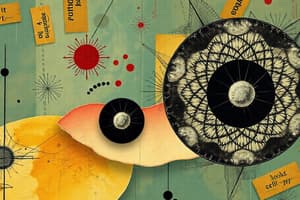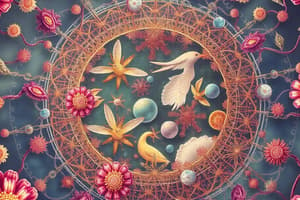Podcast
Questions and Answers
What is the Cell Theory?
What is the Cell Theory?
- All organisms are made up of cells.
- Cells are capable of self-reproduction.
- Cells come only from preexisting cells.
- All of the above. (correct)
What is a plasma membrane?
What is a plasma membrane?
A membrane surrounding the cytoplasm consisting of a phospholipid bilayer with embedded proteins.
What is cytoplasm?
What is cytoplasm?
The region of a cell between the nucleus and the plasma membrane.
What is the function of the cell wall?
What is the function of the cell wall?
What characterizes a eukaryotic cell?
What characterizes a eukaryotic cell?
What is the main difference between eukaryotic and prokaryotic cells?
What is the main difference between eukaryotic and prokaryotic cells?
Both animal and plant cells contain mitochondria.
Both animal and plant cells contain mitochondria.
Chloroplasts are primarily found in animal cells.
Chloroplasts are primarily found in animal cells.
What is the function of the nucleus?
What is the function of the nucleus?
What is chromatin?
What is chromatin?
What are ribosomes?
What are ribosomes?
What does the Golgi apparatus do?
What does the Golgi apparatus do?
What are lysosomes?
What are lysosomes?
What are vacuoles?
What are vacuoles?
What is the function of chloroplasts?
What is the function of chloroplasts?
What is the role of mitochondria?
What is the role of mitochondria?
What are thylakoids?
What are thylakoids?
What is granum?
What is granum?
What is chlorophyll?
What is chlorophyll?
What is the function of actin filaments?
What is the function of actin filaments?
Flashcards
Cell Theory
Cell Theory
All organisms are composed of cells that can self-reproduce, originating from pre-existing cells.
Plasma Membrane
Plasma Membrane
A phospholipid bilayer with proteins, regulating molecule movement and acting as a barrier.
Cytoplasm
Cytoplasm
The aqueous region inside a cell, containing organelles suspended in cytosol.
Cell Wall
Cell Wall
Signup and view all the flashcards
Eukaryotic Cell
Eukaryotic Cell
Signup and view all the flashcards
Eukaryotic vs. Prokaryotic Cells
Eukaryotic vs. Prokaryotic Cells
Signup and view all the flashcards
Chloroplasts
Chloroplasts
Signup and view all the flashcards
Mitochondria
Mitochondria
Signup and view all the flashcards
Ribosomes
Ribosomes
Signup and view all the flashcards
Golgi Apparatus
Golgi Apparatus
Signup and view all the flashcards
Lysosomes
Lysosomes
Signup and view all the flashcards
Vacuoles
Vacuoles
Signup and view all the flashcards
Thylakoids
Thylakoids
Signup and view all the flashcards
Grana
Grana
Signup and view all the flashcards
Chlorophyll
Chlorophyll
Signup and view all the flashcards
Chromatin
Chromatin
Signup and view all the flashcards
Actin Filament
Actin Filament
Signup and view all the flashcards
Nucleus
Nucleus
Signup and view all the flashcards
Study Notes
Cell Theory
- States all organisms consist of cells, which are capable of self-reproduction.
- Cells arise only from preexisting cells, emphasizing their role in biological processes.
Plasma Membrane
- Composed of a phospholipid bilayer embedded with proteins, regulating molecular traffic.
- Serves as a protective boundary between a cell's internal contents and the external environment.
Cytoplasm
- The aqueous region within a cell, situated between the nucleus/nucleoid and the plasma membrane.
- Contains various organelles suspended in the cytosol.
Cell Wall
- Provides structural protection particularly in bacteria, giving shape and rigidity.
- Composed primarily of peptidoglycan, distinguishing bacterial cells from eukaryotic cells.
Eukaryotic Cell
- Characterized by a membrane-bound nucleus and membranous organelles, facilitating greater complexity in functions.
Eukaryotic vs. Prokaryotic Cells
- Eukaryotic cells feature a nucleus, unlike prokaryotic cells, which have no such compartmentalization.
- Eukaryotes also possess a diverse assortment of organelles enabling specialized functions.
Animal and Plant Cells
- Both cell types contain mitochondria, the powerhouse of the cell.
- Plant cells uniquely feature chloroplasts for photosynthesis, enabling them to convert sunlight into energy.
Nucleus
- The most prominent organelle in eukaryotic cells, housing genetic material (DNA).
- Functions as the control center for cellular activities and gene expression.
Chromatin
- A structure composed of DNA strands and proteins within the nucleus, playing a role in packaging DNA.
- Condenses to form chromosomes during cell division.
Ribosomes
- Sites for protein synthesis, translating messenger RNA (mRNA) into polypeptide chains.
- Composed of ribosomal RNA and proteins, crucial for cellular growth and function.
Golgi Apparatus
- Modifies, sorts, and packages lipids and proteins received from the endoplasmic reticulum (ER) into vesicles.
- Involved in lysosome formation, which contain enzymes for intracellular digestion.
Lysosomes
- Membrane-bound vesicles containing hydrolytic enzymes, breaking down macromolecules and bacteria.
- Often referred to as the cell’s waste disposal system.
Vacuoles
- Larger in plant cells, these organelles store substances such as water, salts, sugars, and pigments.
- Help maintain turgor pressure against the cell wall in plant cells.
Chloroplasts
- Organelles that capture sunlight to synthesize carbohydrates through photosynthesis.
- Contain thylakoids where light reactions occur.
Mitochondria
- Membrane-enclosed organelles responsible for producing ATP through cellular respiration.
- Often called the "powerhouse of the cell."
Thylakoids
- Flat sac-like membranes within chloroplasts, essential for the light-dependent reactions of photosynthesis.
- Contain chlorophyll, the pigment crucial for capturing solar energy.
Grana
- Stacks of thylakoids, increasing the efficiency of light absorption for photosynthesis.
- Located within chloroplasts, these structures house chlorophyll.
Chlorophyll
- A green pigment situated in the thylakoid membranes, essential for photosynthesis.
- Captures solar energy, enabling the synthesis of carbohydrates.
Actin Filament
- A type of cytoskeletal filament, integral to cell movement and the transport of organelles within the cell.
- Plays a key role in maintaining cell shape and motility.
Studying That Suits You
Use AI to generate personalized quizzes and flashcards to suit your learning preferences.




